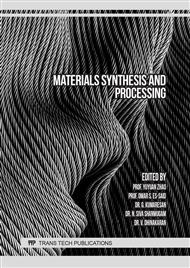[1]
M.L. Wang, R.Y. Chang, C.H. Hsu, Molding Simulation: Theory and Practice, Hanser Publications, (2018).
Google Scholar
[2]
R.Y. Chang, W.H. Yang, Numerical simulation of mold filling in injection molding using a three-dimensional finite volume approach, International Journal for Numerical Methods in Fluids 37, 2001, pp.125-148.
DOI: 10.1002/fld.166
Google Scholar
[3]
F.H. Hsu, K. Wang, C.T. Huang, R.Y. Chang, Investigation on conformal cooling system design in injection molding, Advances in Production Engineering & Management 8, 2013, pp.107-115.
DOI: 10.14743/apem2013.2.158
Google Scholar
[4]
H.S. Park, X.P. Dang, Optimization of Conformal Cooling Channels with Array of Baffles for Plastic Injection Mold, International Journal Of Precision Engineering And Manufacturing 11, 2010, pp.879-890.
DOI: 10.1007/s12541-010-0107-z
Google Scholar
[5]
X.P. Dang, H.S. Park, Design of U-shape Milled Groove Conformal Cooling Channels for Plastic Injection Mold, International Journal Of Precision Engineering And Manufacturing 12, 2011, pp.73-84.
DOI: 10.1007/s12541-011-0009-8
Google Scholar
[6]
H.S. Park, X.P. Dang, Reduction of Heat Losses for the In-line Induction Heating System by Optimization of Thermal Insulation, International Journal Of Precision Engineering And Manufacturing 14, 2013, pp.903-909.
DOI: 10.1007/s12541-013-0119-6
Google Scholar
[7]
H.S. Park, X.P. Dang, Development of a smart plastic injection mold with conformal cooling channels, Procedia Manufacturing 10, 2017, p.48 – 59.
DOI: 10.1016/j.promfg.2017.07.020
Google Scholar
[8]
H. Hassan, N. Regnier, C.L. Bot, G. Defaye, 3D study of cooling system effect on the heat transfer during polymer injection molding, International Journal of Thermal Sciences 49, 2010, p.161–169.
DOI: 10.1016/j.ijthermalsci.2009.07.006
Google Scholar
[9]
H. Hassan, N. Regnier, C. Pujos, E. Arquis, G. Defaye, Modeling the effect of cooling system on the shrinkage and temperature of the polymer by injection molding, Applied Thermal Engineering 30, 2010, pp.1547-1557.
DOI: 10.1016/j.applthermaleng.2010.02.025
Google Scholar
[10]
H. Hassan, N. Regnier, C. Pujos, G. Defaye, 3D Study on the Effect of Process Parameters on the Cooling of Polymer by Injection Molding, Journal of Applied Polymer Science 114, 2009, p.2901–2914.
DOI: 10.1002/app.30812
Google Scholar
[11]
N. T. Giang, P. S. Minh, T. A. Son, T. M. T. Uyen, T. H. Nguyen, H. S. Dang, Study on external gas-assisted mold temperature control with the assistance of a flow focusing device in the injection molding process, Materials 14(4), 2018, p.965 – 992.
DOI: 10.3390/ma14040965
Google Scholar
[12]
T. T. Do, T. M. T. Uyen, P. S. Minh, The Feasibility of an Internal Gas-Assisted Heating Method for Improving the Melt Filling Ability of Polyamide 6 Thermoplastic Composites in a Thin Wall Injection Molding Process, Polymers 13(7), 2021, p.1004 – 1021.
DOI: 10.3390/polym13071004
Google Scholar
[13]
P. S. Minh, M. T. Le, Improving the Melt Flow Length of Acrylonitrile Butadiene Styrene in Thin-Wall Injection Molding by External Induction Heating with the Assistance of a Rotation Device, Polymers 13(14), 2021, p.2288 – 2306.
DOI: 10.3390/polym13142288
Google Scholar
[14]
P. S. Minh, T. M. T. Uyen, T. T. Do, Numerical Study on Gas-Assisted Mold Temperature Control with the Application of Air Cover for Improving the Cavity Temperature in Injection Molding Process, 2020 5th International Conference on Green Technology and Sustainable Development (GTSD), 2020, p.673 – 676.
DOI: 10.1109/gtsd50082.2020.9303159
Google Scholar
[15]
T. M. T. Uyen, N. T. Giang, T. T. Do, T. A. Son, P. S. Minh, External Gas-Assisted Mold Temperature Control Improves Weld Line Quality in the Injection Molding Process, Materials 13(12), 2020, p.2855 – 2874.
DOI: 10.3390/ma13122855
Google Scholar
[16]
H. D. Thuan, T. A. Son, S. M. Pham, Estimate the Melt Flow Length with Internal Induction Heating for the Injection Molding Process, Key Engineering Materials 863, 2020, p.97 – 102.
DOI: 10.4028/www.scientific.net/kem.863.97
Google Scholar
[17]
T. N. Phan, T. T.Do, T. A. Son, P. S. Minh, Study on External Gas-Assisted Mold Temperature Control for Improving the Melt Flow Length of Thin Rib Products in the Injection Molding Process, Advances in Polymer Technology 2019, 2019, p.1 – 18.
DOI: 10.1155/2019/5973403
Google Scholar
[18]
P. S. Minh, T. T. Do, Tran Minh The Uyen, The feasibility of external gas-assisted mold-temperature control for thin-wall injection molding, Advances in Mechanical Engineering 10, 2018, p.1687814018806102.
DOI: 10.1177/1687814018806102
Google Scholar
[19]
P. S. Minh, T. T. Do, A study on the welding line strength of composite parts with various venting systems in injection molding process, Key Engineering Materials 737, 2017, p.70 – 76.
DOI: 10.4028/www.scientific.net/kem.737.70
Google Scholar



